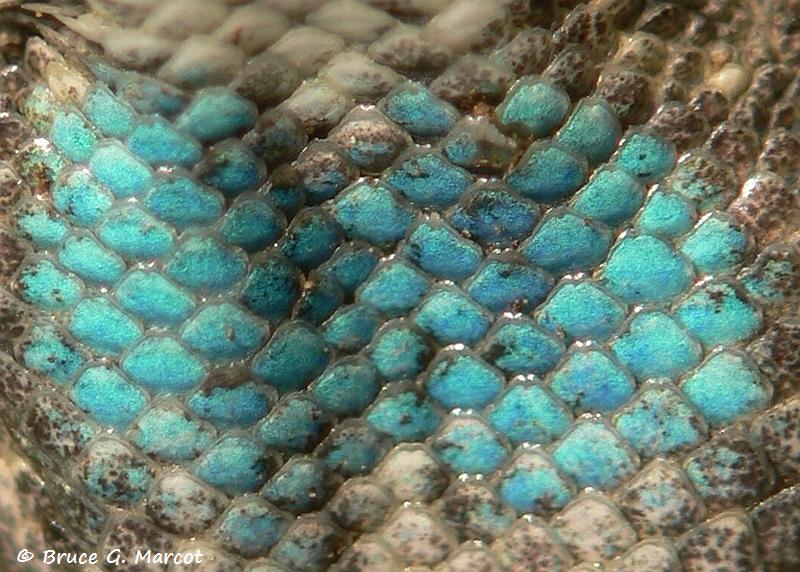
|
|
Blue-Belly |
|
|
Click on images for larger versions
|
Northwestern Fence Lizard (Sceloporus
occidentalis occidentalis), Family Phrynosomatidae [Iguanidae] |
Credit & Copyright: Dr. Bruce G. Marcot
Explanation: Scales of blue! Who is this, and what part of their body are we seeing here?
This is a Fence Lizard ... also called a Blue-Belly ... the name thus revealing what we are looking at.
But ... no ... this is actually the throat pattern:
Further down, we see that the scales on the sides of the belly are indeed ... blue:
... or maybe more of a turquoise.
What's the purpose of this striking color, if the lizard typically sits with its belly on the ground?
The brown-gray on the back helps fence lizard blend wonderfully into various backgrounds,
helping to escape detection ... and various predators.
I photographed this specimen in Paso Robles, California ... putting it into the range of the
Coast Range Fence Lizard, Sceloporus occidentalis bocourtii.
Western fence lizards use the color to signal territoriality to other western fence lizards, by flattening and tilting their body to expose the belly, or by doing ludicrous-appearing "push-ups" as a sign of aggression, thereby exposing their bright blue throat.
Several subspecies of Blue-Bellies -- uh, Western Fence Lizards -- occur throughout western U.S.. I caught and photographed this wonderful specimen in the oak woodlands outside the town of Mosier, up the Columbia River Gorge in Oregon, putting it into the range of the Northwestern Fence Lizard subspecies. Here is that location shown on an overall range map of the species:A curious overall distribution, indeed ... with gaps along the Oregon coast, the Cascade Mountains, northcentral Oregon ... and with several isolated populations such as around Puget Sound and Seattle, and eastern Washington state.
Information:
Cooper, W.E., Jr., and N. Burns. 1987. Social significance of ventrolateral coloration in the fence lizard, Sceloporus undulatus. Animal Behavior 35(2):526-532.
Marcot, B.G., B.C. Wales, and R. Demmer. 2003. Range maps of terrestrial species and natural areas in the interior Columbia River Basin and northern portions of the Klamath and Great Basins. General Technical Report PNW-GTR-583. USDA Forest Service. Portland OR. 304 pp. http://www.fs.fed.us/pnw/publications/gtr583/.
Sheldahl, L.A., and E.P. Martins. 2000. The territorial behavior of the western fence lizard, Sceloporus occidentalis. Herpetologica 56(4):469-479.
Next week's picture:
Weka in the Henhouse: A Lesson on Assisted Reintroduction
< Previous ... | Archive |
Index |
Location | Search | About EPOW | ... Next >
|
|
Author & Webmaster: Dr.
Bruce G. Marcot
Disclaimers and Legal
Statements
Original material on Ecology Picture of the Week ©
Bruce G. Marcot
Member Theme of The Plexus